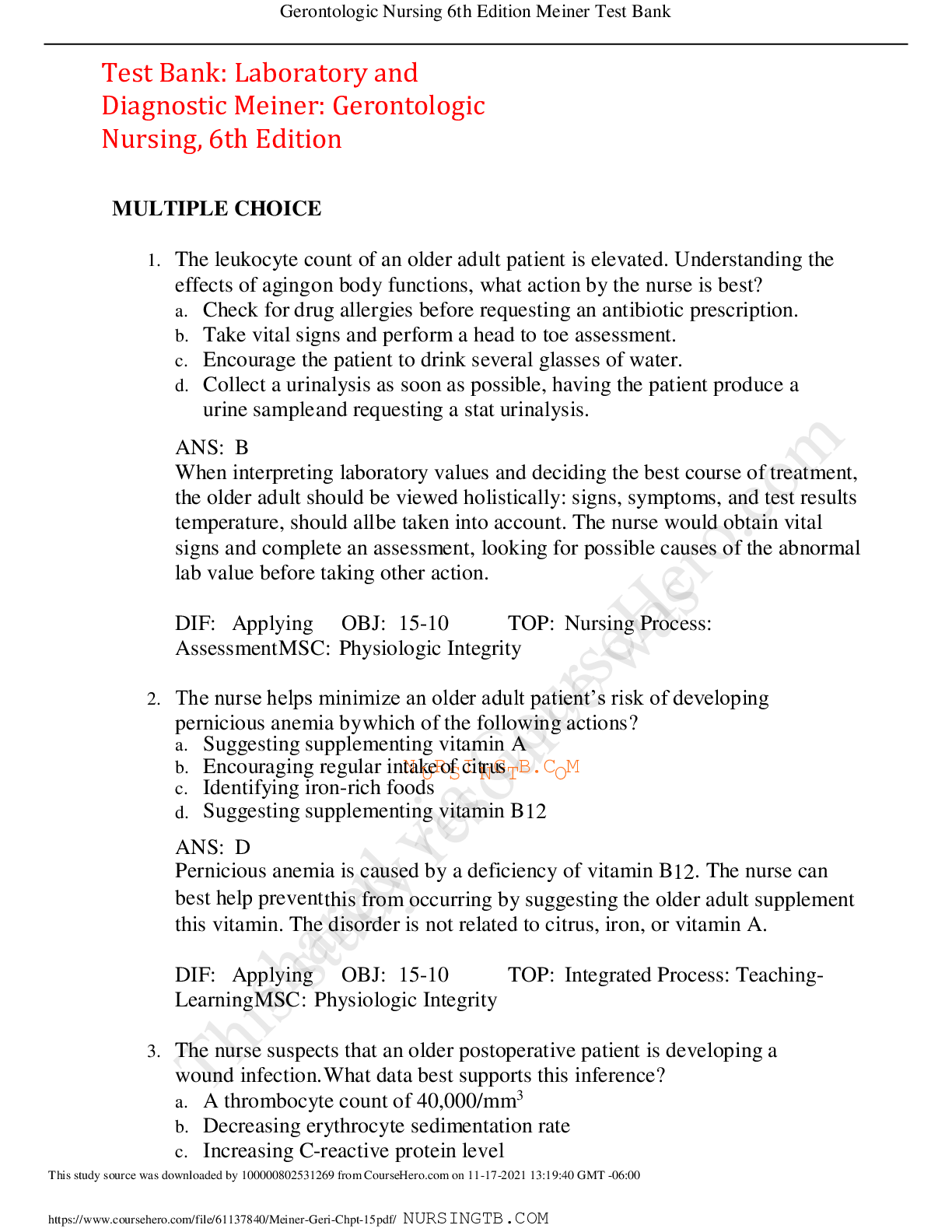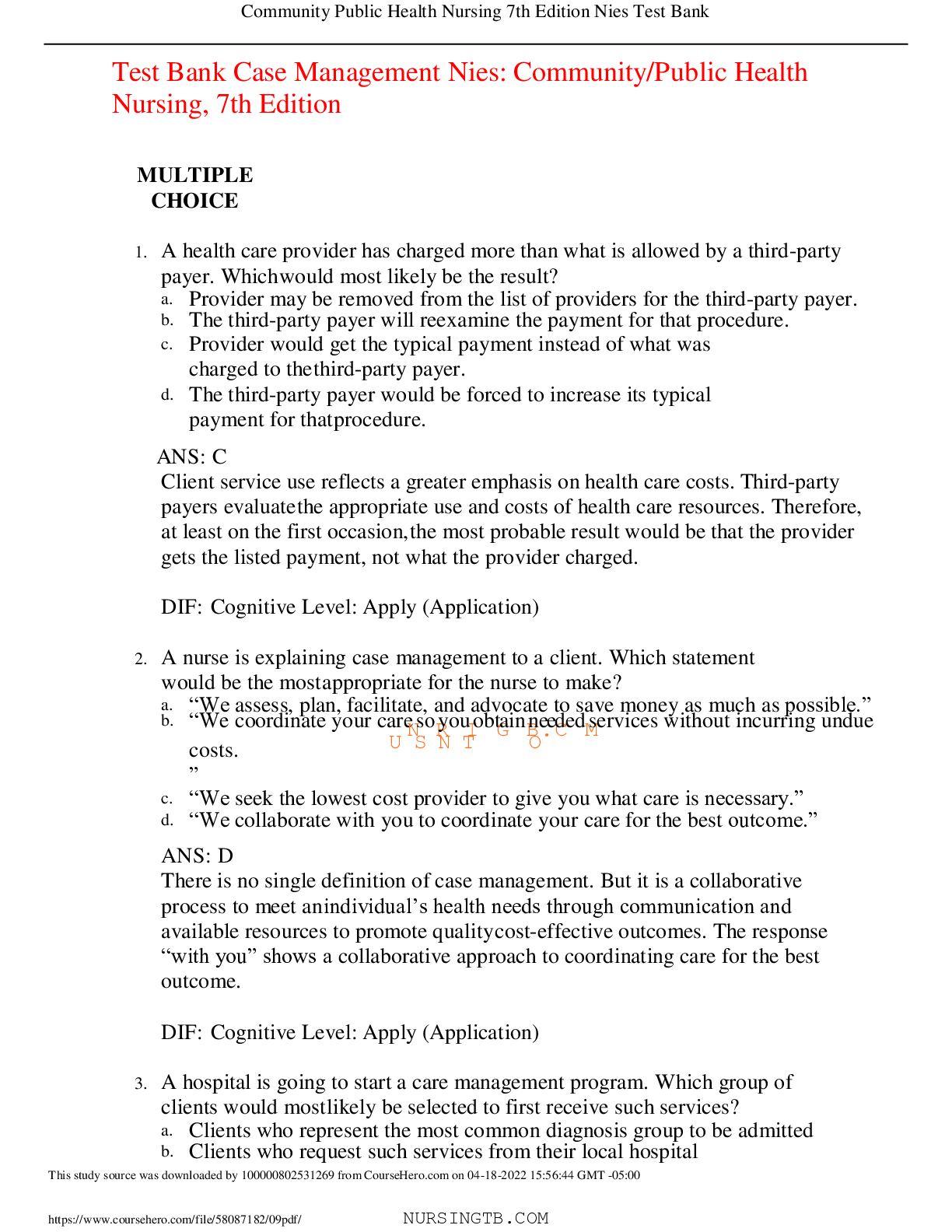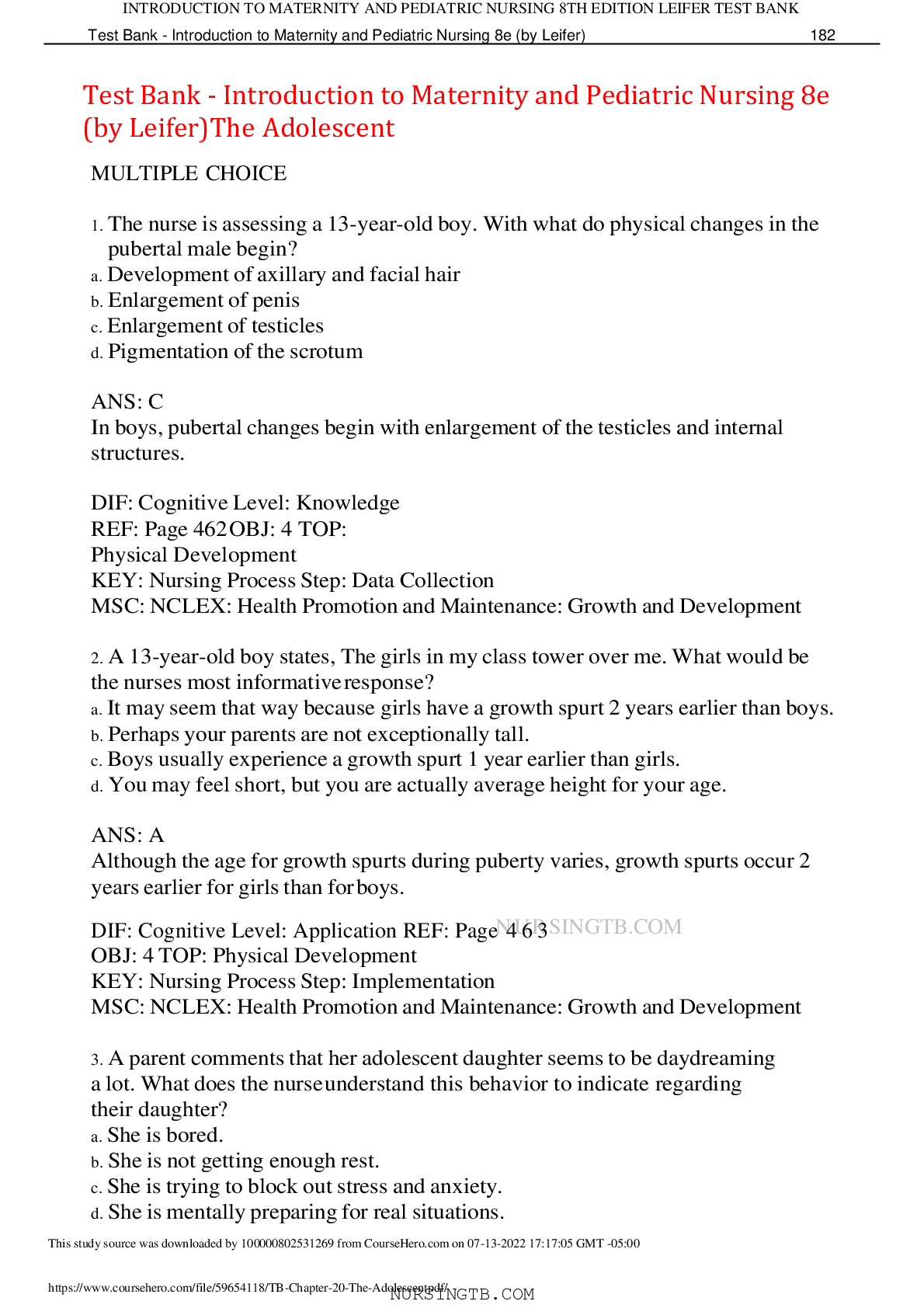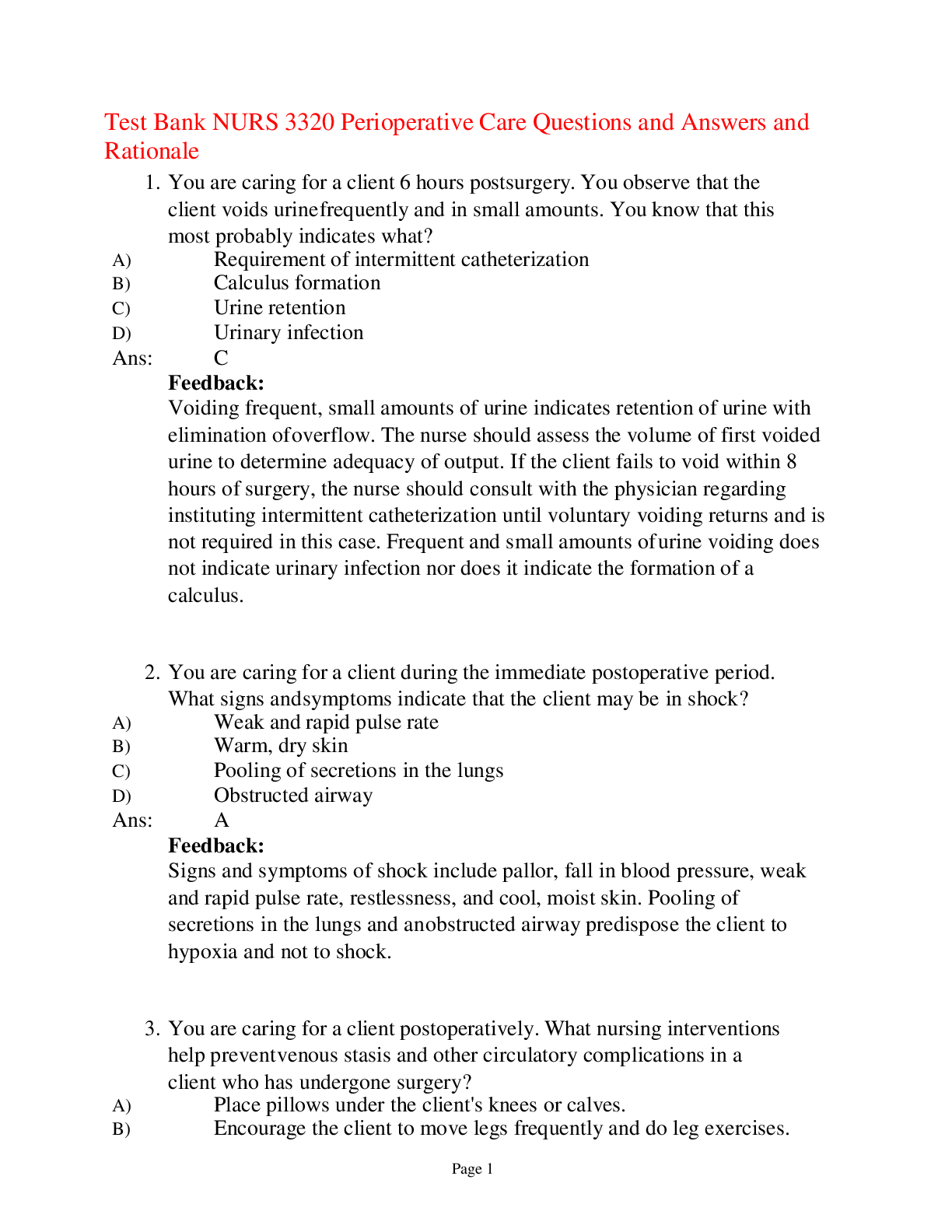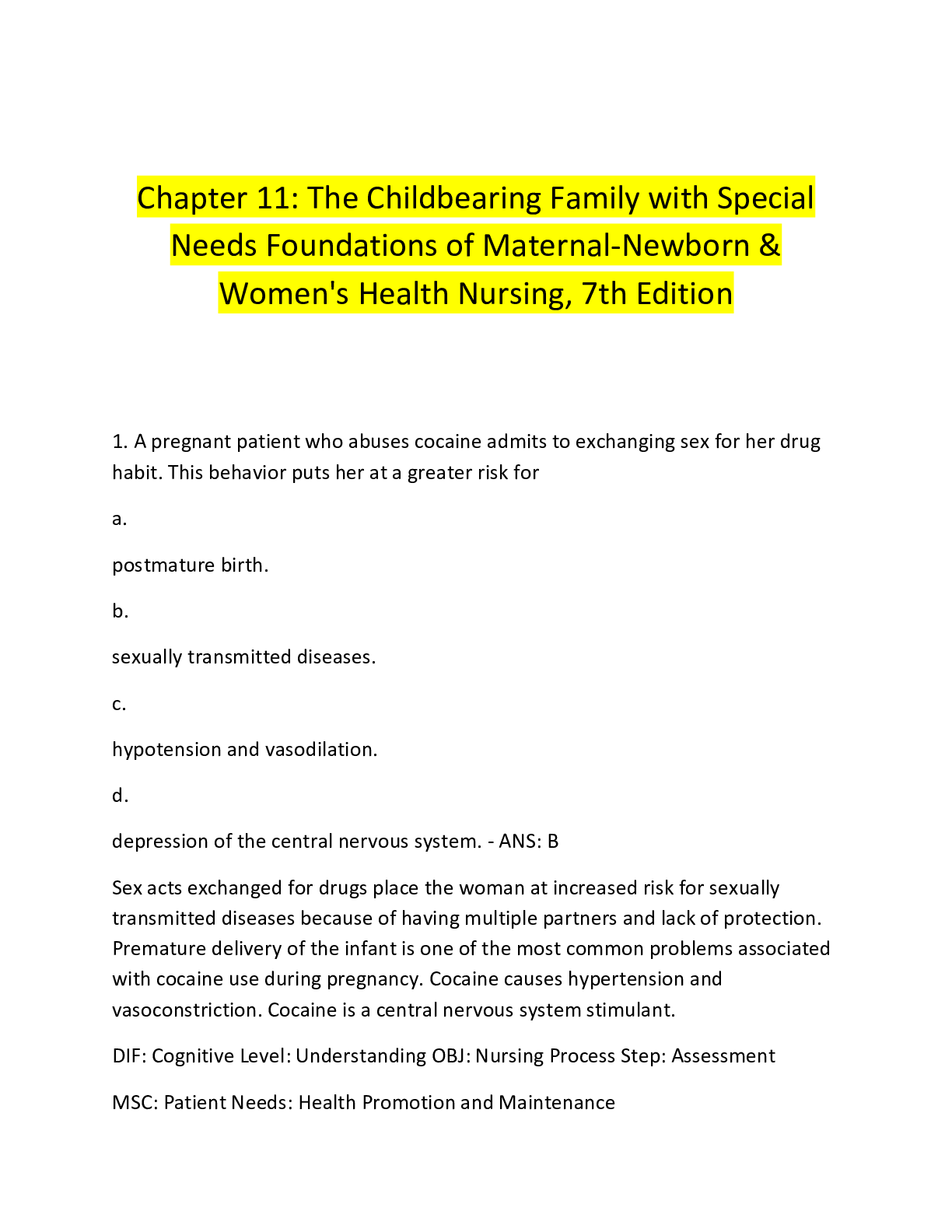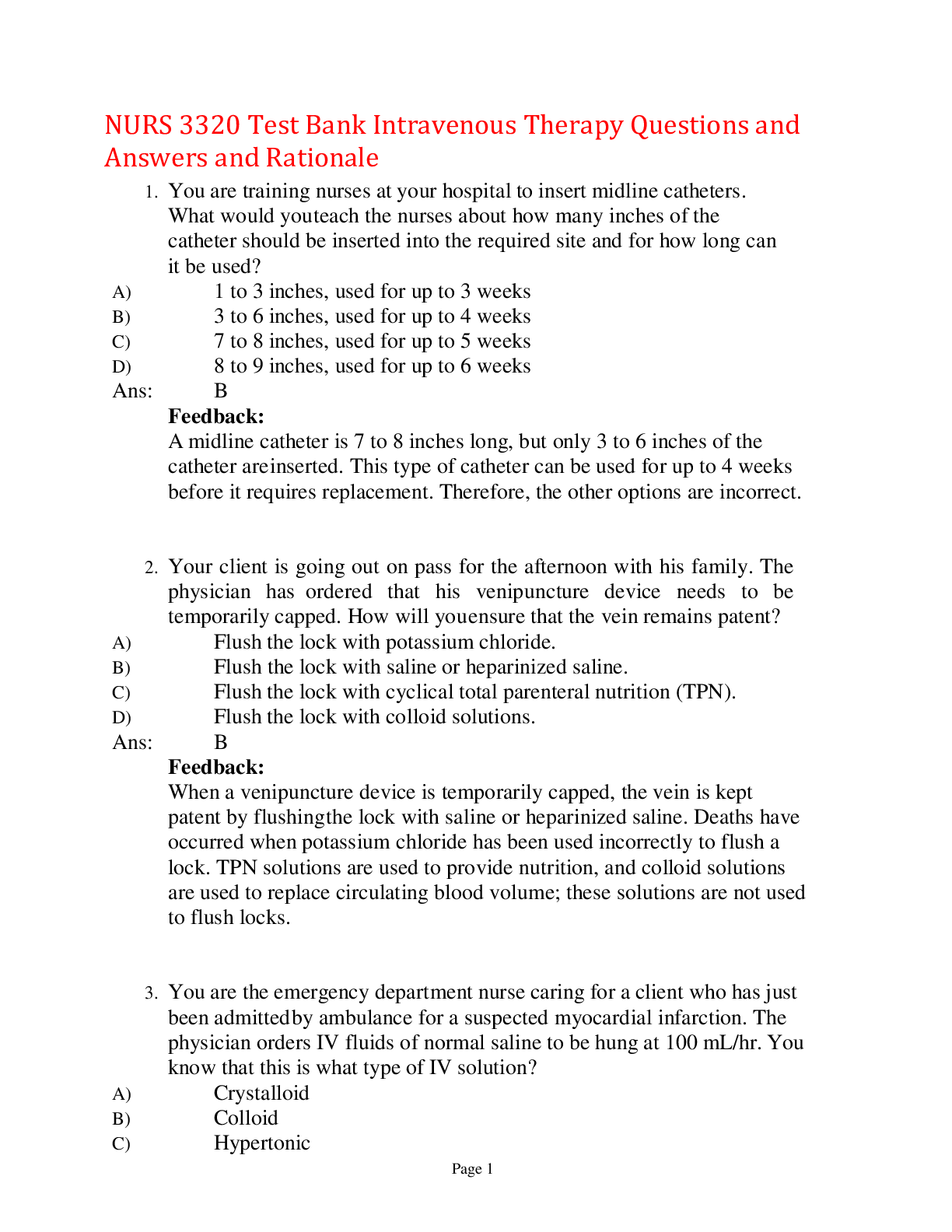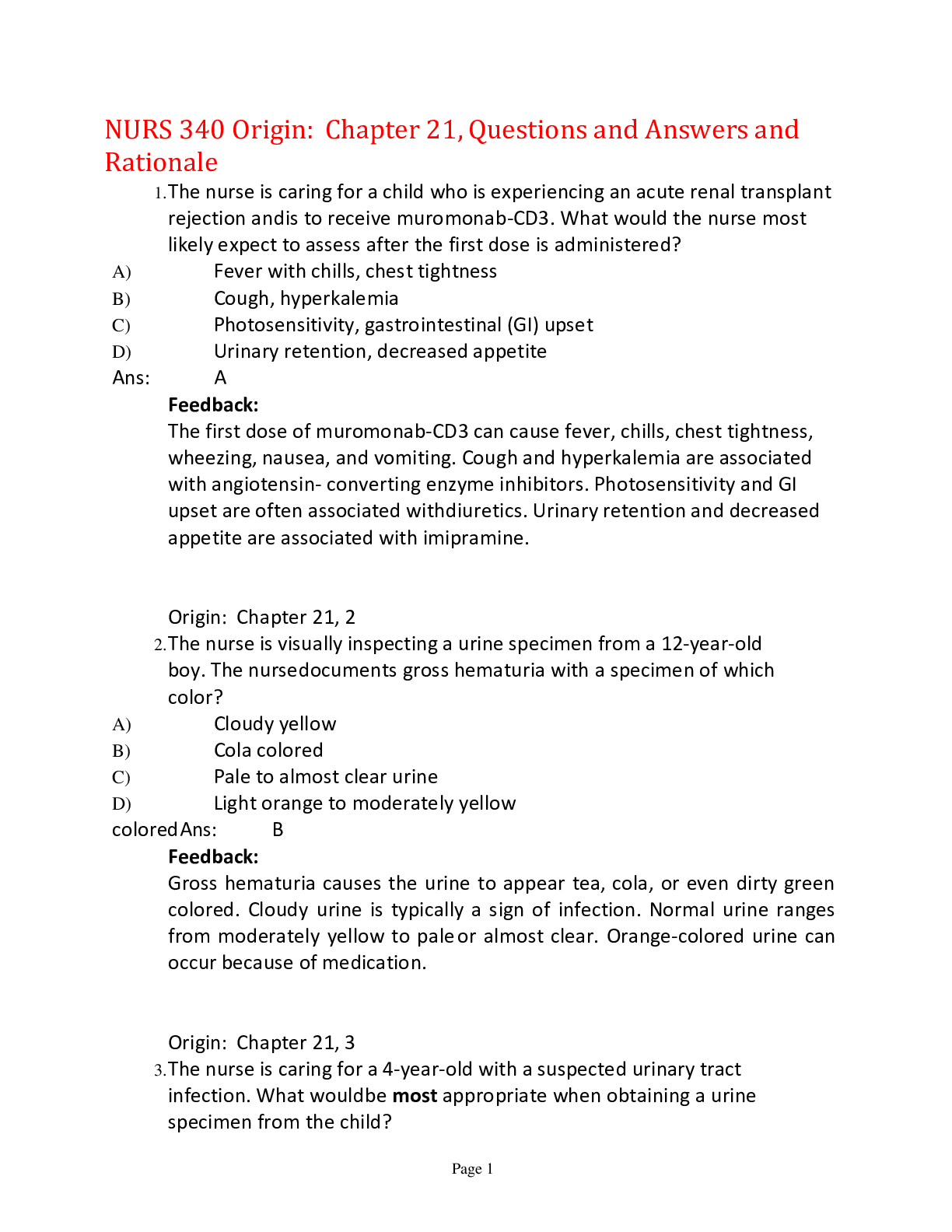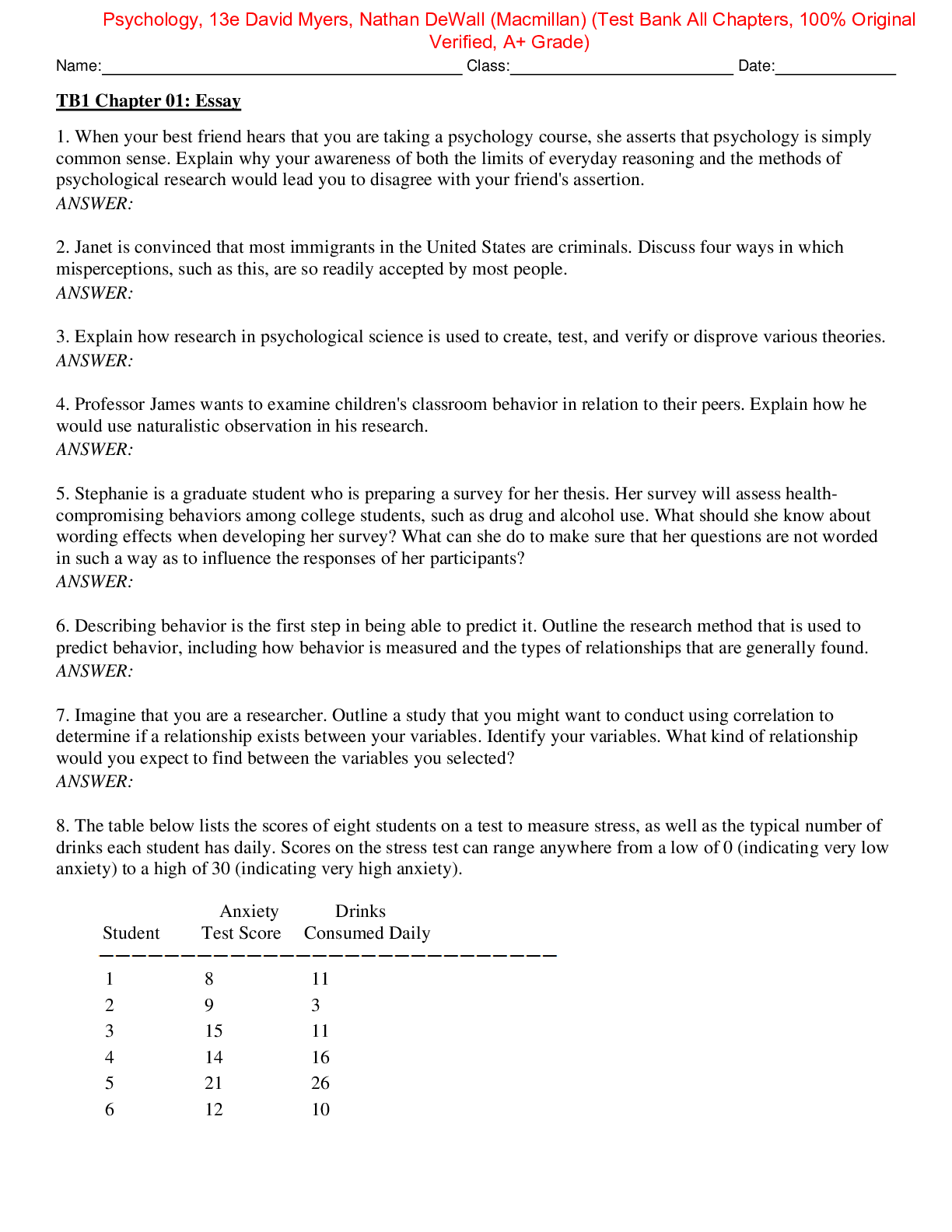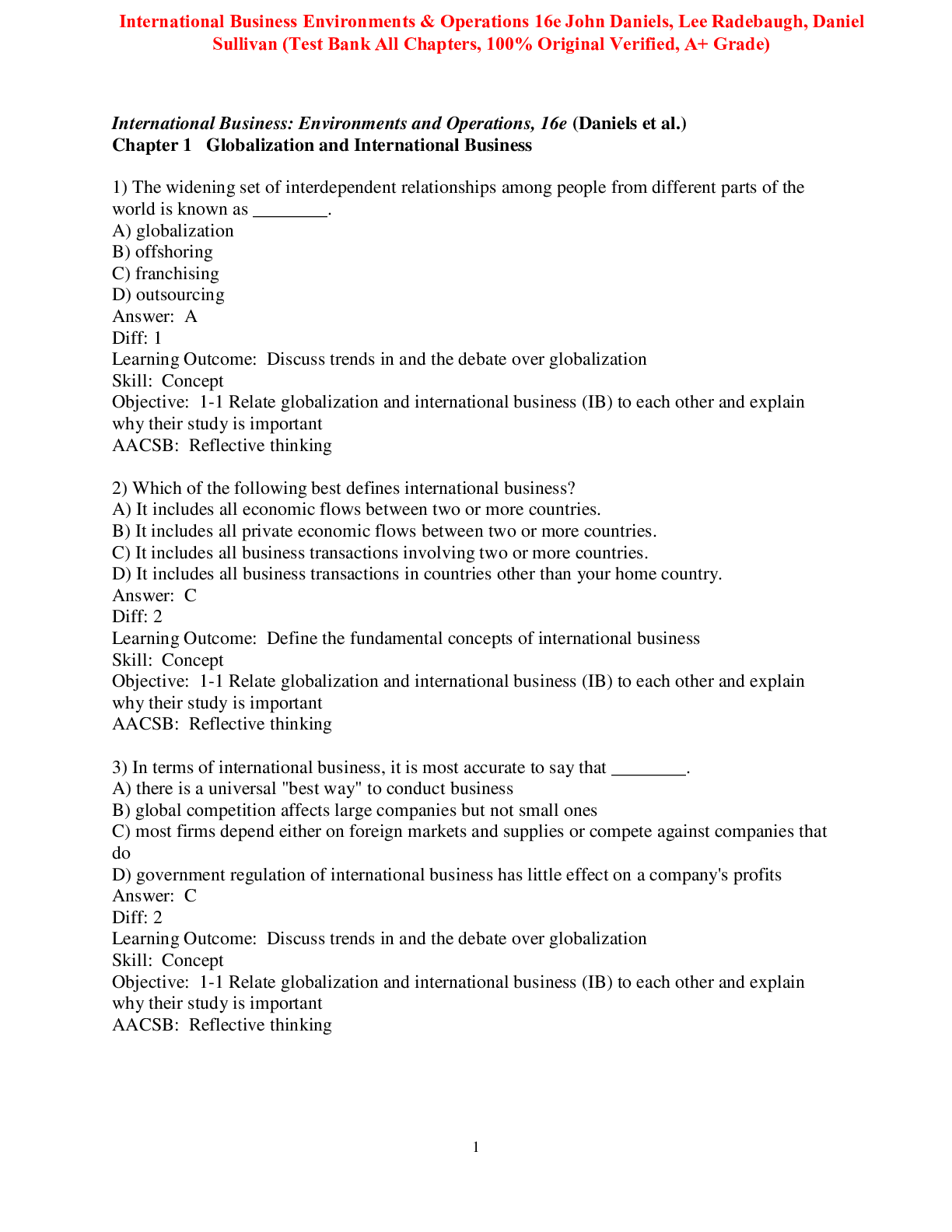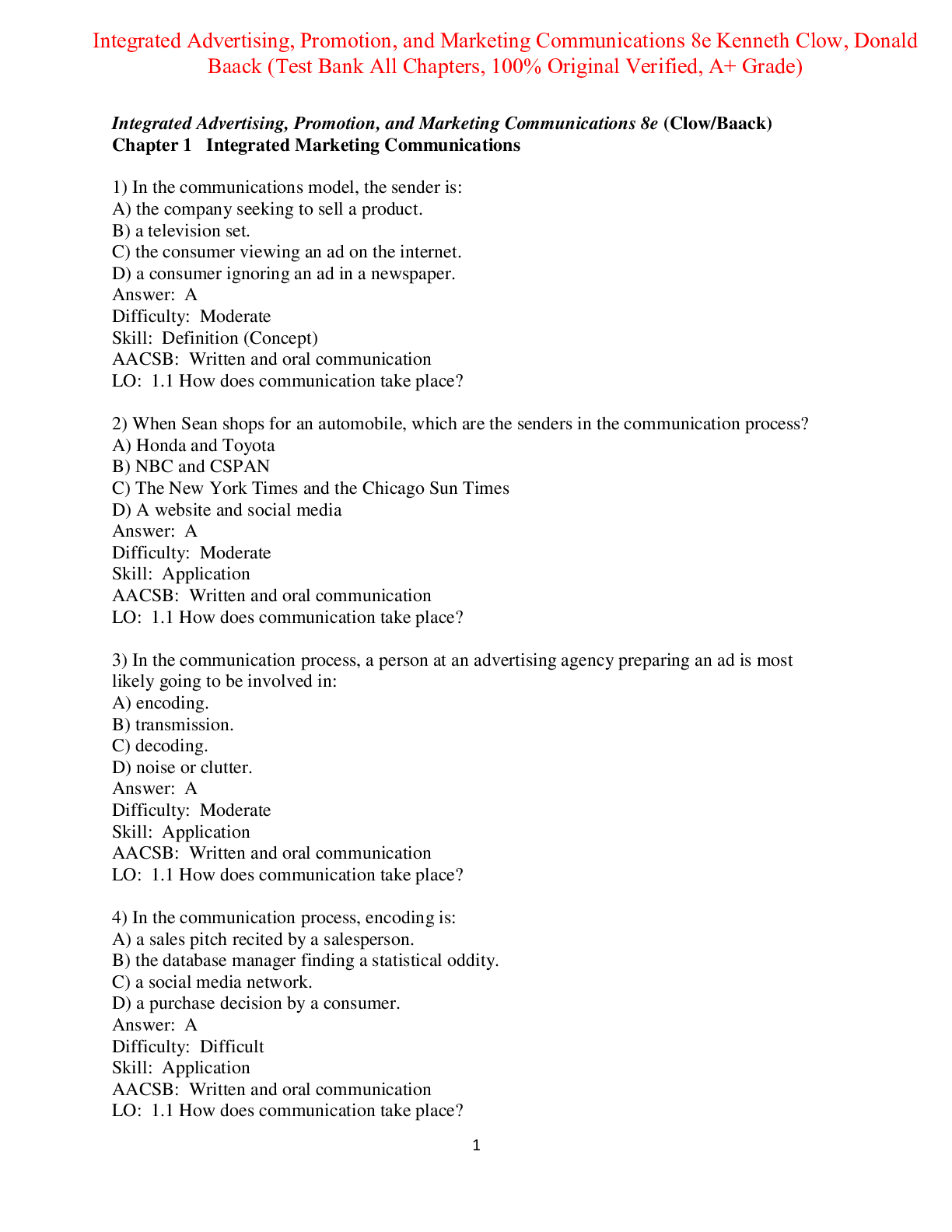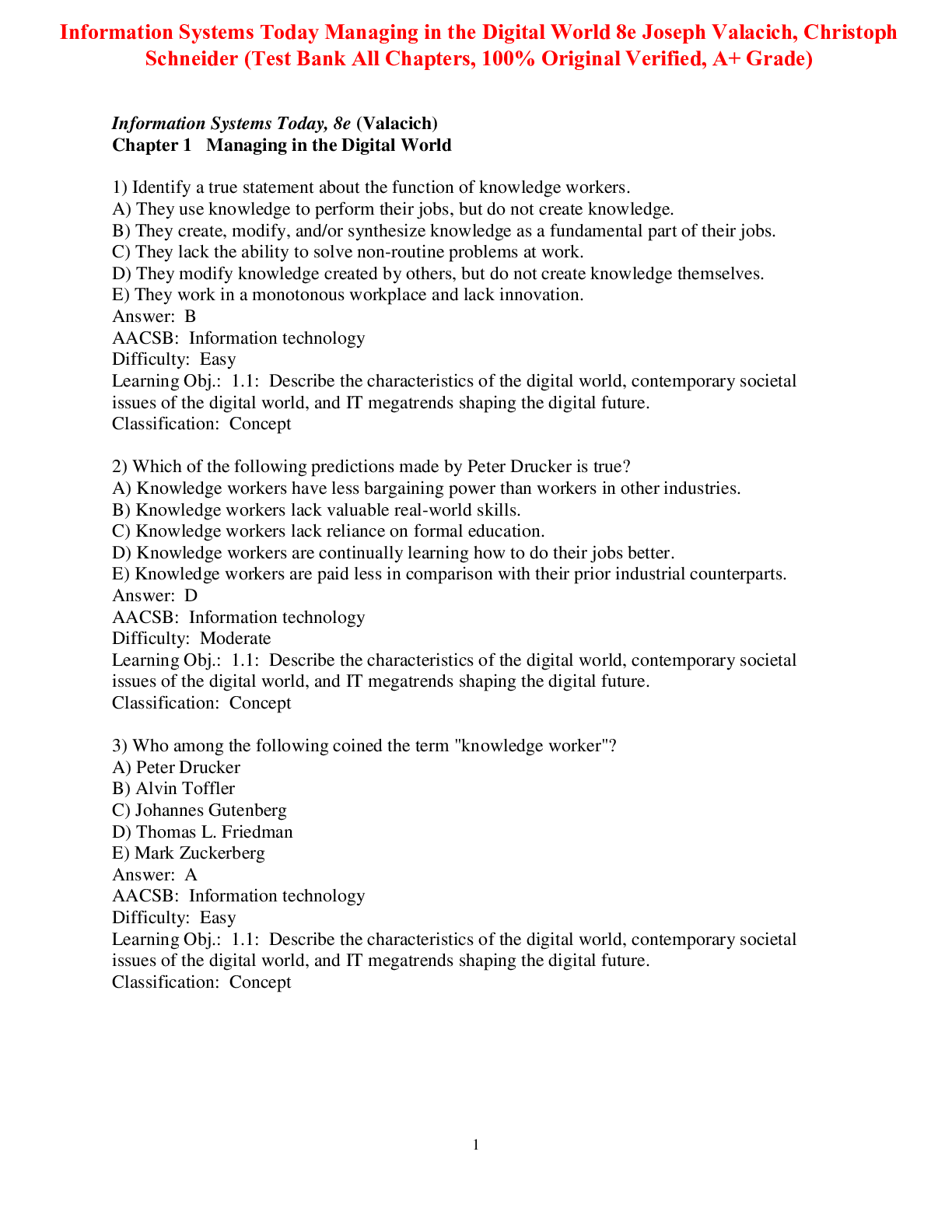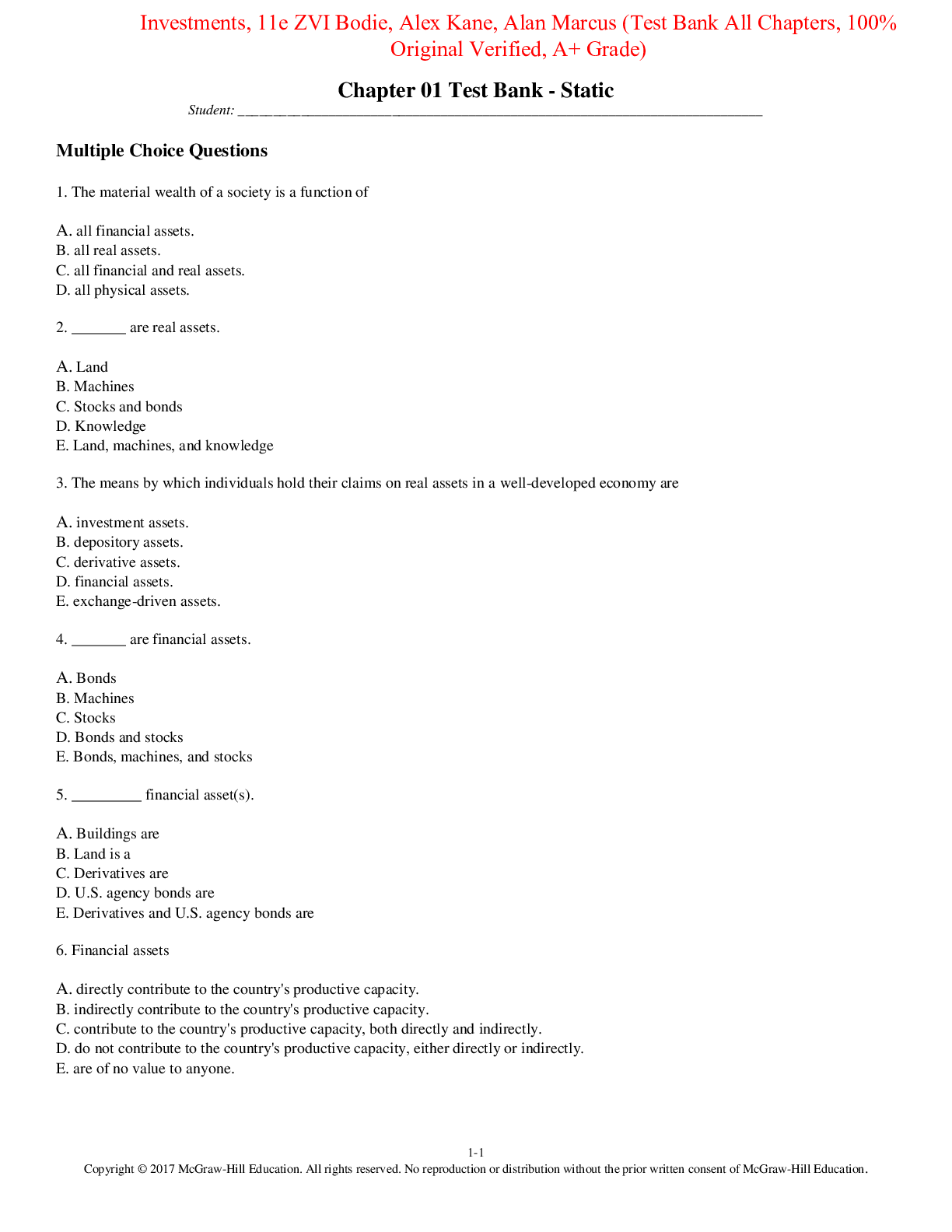*NURSING > TEST BANK > Test Bank NSG 210 Disaster Situations Questions & Answers and Rationale,100% CORRECT (All)
Test Bank NSG 210 Disaster Situations Questions & Answers and Rationale,100% CORRECT
Document Content and Description Below
Test Bank NSG 210 Disaster Situations Questions & Answers and Rationale 1. The nursing instructor is talking with the students about botulism. The instructor tells the students that when caring for a... client with botulism, what condition is most likely to cause death? A) Diplopia B) Dysphagia C) Paralysis of respiratory muscles D) Dysarthria Ans: C Feedback: In botulism, paralysis of respiratory muscles poses the greatest potential for lethality. Diplopia (double vision), dysarthria (difficulty in speaking), and dysphagia (difficulty in swallowing) are all early signs of botulism. 2. You are an emergency department nurse working triage during a disaster. Why should you tag a victim after assessment in a disaster situation? A) To know the victim's name B) The tag states the triage category of the victim. C) Someone else does not duplicate the assessment. D) Call for immediate hospitalization. Ans: C Feedback: The tag is an indication that the victim has been assessed by a nurse. This ensures that the nurse or another medical person does not spend time assessing the same person twice. The tag does not name the victim, state the triage category, or contain instructions. 3. You are caring for radiation victims. What is the most important factor that you should consider to assess a client's chance of survival in acute radiation syndrome (ARS)? A) Dosage of gamma radiation B) Concentration of nerve gas C) Mode of infection D) Direct physical contact Ans: A Feedback: The chance of surviving ARS depends on the dosage of gamma radiation a person receives. ARS is not related to chemical (gas) or biologic (infection, contact) disasters. 4. The nurse caring for victims of a volcano eruption knows that this disaster is categorized as a natural disaster. What is the other category of disaster? A) Man-made B) Artificial C) Earthly D) Human Ans: D Feedback: There are essentially two types of disasters: (1) natural disasters such as earthquakes, floods, and hurricanes; and (2) human disasters that may be intentionally or unintentionally caused such as explosions, fires, and acts of terrorism. Options A, B, and C are simply distractors. 5. You are a nurse caring for clients in the emergency department who have been admitted from the area surrounding a nuclear power plant. There had been a small explosion at the plant and a small amount of radiation had escaped. You know that this is what type of a disaster? A) Natural B) Explosive C) Chemical D) Radiologic Ans: D Feedback: Radiologic disasters can occur in the following ways: explosion of a dirty bomb, damage to or human error in a nuclear power plant facility, and nuclear blast. The scenario does not describe a natural disaster or a chemical disaster. Option B is only a distractor. 6. An ICU nurse is caring for a radiation victim who is being treated with Prussian blue. You know that Prussian blue works by doing what? A) Prevents radioactive iodine from reaching the thyroid gland B) Attaches to radioactive iodine and promotes its excretion C) Traps cesium in the intestine to prevent its absorption D) Prevents cesium from being trapped in the small bowel Ans: C Feedback: Prussian blue is a dye used to treat internal contamination with ingested radioactive cesium. Prussian blue promotes the excretion of cesium by trapping it in the intestine and preventing its absorption. It is not given for radioactive iodine contamination and does not prevent cesium from being trapped in the small bowel. 7. You are taking a class on chemical disasters with your local emergency response team. What toxins would you be learning about? Select all that apply. A) Blistering agents B) Psychologic agents C) Contact emulsifiers D) Nerve agents E) Cyanide Ans: A, D, E Feedback: Examples of extremely toxic chemicals include nerve agents, cyanide, respiratory toxins, and blistering agents. Options B and D are distractors for this question. 8. The nurse is caring for a victim of a chemical disaster. Medications given in the treatment of this client include amyl nitrite, sodium nitrite, and sodium thiosulfate. What chemical agent does the nurse know this client has been exposed to? A) Sarin B) Mustard gas C) Cyanide D) Anthrax Ans: C Feedback: They administer one or all of the following antidotes: amyl nitrite, sodium nitrite, and sodium thiosulfate. Amyl nitrite promotes the formation of methemoglobin, which combines with cyanide to form nontoxic cyanmethemoglobin. Therefore, options A, B, and D are incorrect. 9. You are the nurse caring for three clients who have been diagnosed with anthrax. They were exposed after boarding a flight where a white powdery substance was found in one of the restrooms. You know that these clients would be classed as being victims of which of the following? A) A biologic disaster B) A natural disaster C) A radiologic disaster D) A chemical disaster Ans: A Feedback: Anthrax is a biologic agent that could be the cause of a biologic disaster, one in which pathogens or their toxins cause harm to many humans and other living species. Anthrax is not a natural, radiologic, or chemical agent of disaster. 10. The nurse is caring for a client who has been exposed to radiation. The client is being treated with diethylenetriamine pentaacetate (DTPA) to reduce the organ damage from radiation. The nurse knows that DTPA is administered how? A) Orally B) Injection C) Intravenous D) Rectally Ans: B Feedback: Diethylenetriamine pentaacetate (DTPA) is an injectable salt or inhalant spray containing calcium (Ca-DTPA) or zinc (Zn-DTPA) and is used to treat internal contamination with radioactive substances, such as plutonium. It is most effective if given within the first 24 hours of exposure, but DTPA may still provide beneficial effects for days to weeks after contamination. 11. The nurse educator is developing a teaching plan to prepare nurses for a disaster situation. Which teaching method is best? A) Develop an online module. B) Prepare a PowerPoint presentation for review. C) Coordinate a demonstration of a simulated disaster. D) Conduct a simulation for the nurses to have a role as participants. Ans: D Feedback: When preparing a teaching plan, it is best to include a simulation where the nurses can participate. The results of research demonstrate that participation in the activity increases the students' level of comfort with their assigned roles. The other options are good for providing background information. 12. The nursing supervisor has been notified of a large industrial fire with multiple injuries started with an electric short. When notifying the nursing peers, the nurse would classify this as which type of disaster? A) A natural disaster B) A human disaster, intentionally caused C) A human disaster, unintentionally caused D) Not classified as a disaster Ans: C Feedback: A fire of an electrical cause is classified as a human disaster of an unintentional cause. A natural disaster is an earthquake or flood that is caused by nature with no human influence. A human disaster, intentionally caused is when a fire occurs, and a person intentionally starts the fire. Because a large industrial fire has injured people, it is classified as a disaster. 13. The nurses are preparing the healthcare facility for clients injured in an explosion. While understanding the characteristics of explosives, what would be the focus of the facility? A) Preparing the operating room B) Arranging a temporary morgue C) Mobilizing supplies to the emergency department D) Contacting law enforcement for crowd control Ans: A Feedback: Postexplosion injuries generally cause penetrating and blunt trauma. Preparing the operating room for victims expedites care to the critically injured. Arranging a temporary morgue and contacting law enforcement is the responsibility of the administration. Mobilizing supplies is an important task to be prepared for client care. 14. The nurse, on a mission trip, is caring for a client with internal radiologic contamination from the fallout. The client states, “I need to get this out of me, and then I will be done with it.” The nurse is most correct to reply which of the following? A) “Yes, we need to assure that we clean any debris from your wound which may be contaminated.” B) “Yes, but you may have lingering effects from the exposure to your body.” C) “Yes, but you must also consider further exposure from contaminated food and water sources.” D) Yes, we need to continue to document your recovery process and further disease processes.” Ans: C Feedback: Internal radiologic contamination occurs from exposure to fallout on the skin, in a wound, inhaled, or consumed through food and water. It is the nurse's responsibility to advise the client if further harm may occur and ways to decrease the risk. 15.A client, contaminated following exposure to radiation, is brought to the hospital for assessment. Which nursing action is essential? A) Assess the client for respiratory concerns. B) Place the client in strict isolation. C) Obtain vital signs and lab work. D) Refer the client to the triage area. Ans: B Feedback: It is important for the nurse to realize that a contaminated person can contaminate others through contact with body fluids or surfaces which he or she touches. Upon arrival to the hospital, the client is placed in strict isolation to minimize the exposure of others. The client will then have vital signs and a complete assessment. 16. The nurse researcher has been brought to an area following a radiologic disaster 2 years before. The nurse will be interviewing individuals regarding their health status. Which would the nurse document as a long-term effect of exposure? Select all that apply. A) Heart disease B) Thyroid cancer C) Leukemia D) Cleft lip and palate E) Stillbirths F) Bipolar disorder Ans: B, C, D, E Feedback: The nurse is correct to assess for long-term effects stemming from a radiologic disaster. Long-term effects include thyroid cancer, leukemia, and non-Hodgkin's lymphoma. In addition, genetic effects have seen among infants conceived shortly before or after the radiologic disaster. Some include major congenital defects such as cleft lip and palate, stillbirths, impaired growth and development, and a shorter life expectancy. 17. The nurse is working the triage, phone answering questions about the radiologic disaster. When in the fallout period of the disaster, which suggestion is most appropriate? A) Stay with friends and family in an outdoor area with good ventilation. B) Remove all outer garments before entering a house or shelter. C) Use a fan to circulate air from the outdoors to the inside. D) Bring all outdoor pets inside to limit their exposure. Ans: B Feedback: During the fallout period when particles are returning to the ground, the main concern is to limit exposure. To limit exposure, the nurse is most correct to instruct to remain indoors and prevent the outside air to mix with the indoors. This includes removing all outer garments before entering a house or shelter. Other considerations include sealing windows, turning off all fans, placing outdoor clothes and shoes in a plastic bag, and not having contact with outdoor pets. 18. The nurse is caring for a client who is critically ill and has high radiation levels in the system. When discussing the needs of patient care and the need to protect nursing staff, which is discussed as the optimal barrier against gamma radiation? A) A protective face mask and shield B) Minimal exposure and gloving C) Maintaining a proximity distance D) Lead barriers and protective aprons Ans: D Feedback: The optimal barrier against gamma radiation is lead. All other options may also be incorporated in the plan of care. 19. The nurse is caring for a client prescribed Prussian blue. Which teaching instruction is most helpful? A) Prussian blue can lead to joint pain. B) Prussian blue can turn the mouth, teeth, and stools blue. C) Prussian blue can provide a blue tinge to the skin resembling cyanosis. D) Prussian blue can alter the taste buds and decreasing food consumption. Ans: B Feedback: It is most helpful to instruct on changes the client may see with medication administration so not to alarm the client if it happens. Prussian blue does turn the mouth, teeth and stools blue. It does not alter taste buds, lead to joint pain, nor turn the skin a blue tinge. 20. Which isolation category should the nurse use to guide care when caring for a client with anthrax? A) Standard precautions B) Droplet precautions C) Airborne precautions D) Contact precautions Ans: A Feedback: Standard precautions, measures for reducing the risk of transmitting pathogens, are sufficient for caring for clients infected with anthrax. These precautions are for all patients being cared for in the hospital. Droplet, airborne, and contact precautions initiate additional measures beyond those for standard precautions. 21. The nurse is instructing on bioterrorism agents. Which of the following does the nurse emphasize as an agent which is transmitted from person to person? A) Anthrax B) Botulism C) Smallpox D) Varicella Ans: C Feedback: Smallpox is highly contagious and caused by a variola virus. Individuals infected with the botulinum toxin and anthrax are not at risk to others; there are no reports of person to person transmission. Varicella, commonly called the chickenpox, is contagious but not a bioterrorism agent. 22. The nurse is caring for a client diagnosed with botulism. Which medication classification does the nurse anticipate? A) An antibiotic B) An anti-inflammatory C) Antipyretics D) Antitoxins Ans: D Feedback: Botulism is a disease that develops from the neurotoxin produced by Clostridium botulinum. Botulinum antitoxin is the only treatment after exposure to lessen the severity of symptoms. Antibiotics are used for anthrax. Supportive treatments such as antipyretics are used for smallpox. Anti-inflammatory medications are not treatments for botulism. 23. The nurse is advising a community group on hospital procedures established for a bioterrorism attack. The nurse specifically addresses which agent where victims need a room under negative air pressure? A) Anthrax B) Smallpox C) Cyanide poisoning D) Botulism Ans: B Feedback: Clients with smallpox are under strict contact transmission-based precautions in a room under negative pressure air. Standard precautions are necessary for anthrax. There is no further precautions for cyanide poisoning or botulism. 24. The nurse is caring for a client affected by a nerve agent. The nurse quickly gives a tutorial on the neurotransmitters and nervous system affected. Which couplet is most correct? A) Acetylcholine, parasympathetic nervous system B) Serotonin, sympathetic nervous system C) Norepinephrine, sympathetic nervous system D) Dopamine, parasympathetic nervous system Ans: A Feedback: Nerve agents cause fatal consequences by inhibiting acetylcholinesterase. Acetylcholinesterase is an enzyme that inactivates acetylcholine, a neurotransmitter of the parasympathetic nervous system. No other option is correct. 25. The student nurse is completing a simulation where a client is the victim of nerve gas. The instructions are for the student to set up the room and have all needed supplies available. Which medication does the student nurse ensure is in the medication administration system to control seizures? A) Phenobarbital intramuscular B) Neurontin tablets C) Valium intravenous injection D) Dilantin tablets Ans: C Feedback: The students nurse is correct to have Valium intravenously on hand for seizure activity. When seizure activity occurs, the intravenous route is the best option to deliver the medication safely and rapidly into the system. It would be very difficult to administer medication both orally and intramuscularly. 26. The nurse comes across a group (four individuals) overcome by a toxic gas substance and unconscious. Place the nursing action in order of what the nurse would do first? (Use all options.) A) Eliminate the source of the toxic gas. B) Begin first aid or supportive measures. C) Assess the clients for spontaneous breathing. D) Call 911 for emergency assistance. E) Move the clients to fresh air. Ans: A, B, C, D, E Feedback: The first action is to eliminate the source of the toxic gas. If not, the nurse could be overcome by the gas also. Next, the nurse would move the clients to fresh air, getting oxygen into the system, if breathing spontaneously. Next, assess each client's respiratory status and if spontaneous breathing is present. Provide rescue breathing if breathing is not present. Call 911 and report client assessment findings and nursing measures already provided. Begin first aid or supportive measures, as directed, until assistance occurs. 27. The nurse is caring for a client with cyanide poisoning. The nurse is most correct to assess which systems where manifestation of the poisoning primarily occurs? A) Cardiovascular and respiratory system B) Gastrointestinal and musculoskeletal system C) Cardiovascular and neurological system D) Sensory and respiratory system Ans: C Feedback: Cyanide poisoning is manifested primarily by the heart/cardiovascular system and brain/neurological system. Symptoms include tachycardia, cardiac dysrhythmias, low blood pressure, restlessness, headache, loss of consciousness, and then respiratory failure. 28. The nurse is caring for a client exposed to a blistering agent. While the nurse is quickly decontaminating the client by showering and bagging all client clothing, what is the nurse simultaneously assessing for? A) Neurological compromise B) Respiratory compromise C) Cardiovascular compromise D) Sensory neglect Ans: B Feedback: A person exposed to a blistering agent or vesicant must be decontaminated immediately, with clothing removed and bagged. Irrigation of the victim's eyes and application of topical analgesia, antibiotics, and lubricants to the skin occur. Simultaneously, the nurse is assessing the respiratory system for airway obstruction because blisters from inhaled toxics can swell obstructing respiratory passages. 29. The nurse is working at a natural disaster scene. A patient requires triage and treatment. Which category would the patient be assigned to? A) Expectant B) Delayed C) Immediate D) Minimal Ans: A Feedback: The expectant category provides comfort and emotional support to victim. These clients will be transported when resources become available. Victims are stabilized via first aid in the immediate category, which assists the medical personnel when the client gets to the treatment area. The delayed category is for stable victims who can wait up to 10 hours for care. The minimal category is for minor injuries. 30. The nurse identifies four nursing diagnosis for a client exposed to toxin. Which nursing diagnosis would be prioritized last? A) Impaired Skin Integrity B) Ineffective Coping C) Fluid Volume Deficit D) Risk for Contamination Ans: D Feedback: When prioritizing nursing diagnosis, the nurse would place an actual diagnosis ahead of a “risk for” diagnosis. When identifying a “risk for” diagnosis, the nurse is identifying a potential problem which needs assessment to prevent or identify early the diagnosis. 31. The nurse is evaluating a skin lesion on a client brought to the emergency department. The nurse notes characteristics of chickenpox but has the physician evaluate the lesion for which biologic disaster agent? A) Botulism B) Smallpox C) Rubella D) Anthrax Ans: B Feedback: Smallpox may be mistaken for chickenpox due to the characteristics of the lesions. Botulism is a neurological toxin. Rubella is a communicable disease. Anthrax is a spore- forming bacterium that is inhaled or injected. 32. The nursing staff, working in an emergency room, begins to see an influx of clients with the following condition: acute nausea and vomiting; redness and itchiness of the skin, leading to open sores; bleeding from the nose, mouth, and gums; and blisters in the mouth and throat. Which condition is suspected? A) A food poisoning B) Acute radiation syndrome C) Anthrax contamination D) Manifestations of botulism Ans: B Feedback: The stated symptoms are characteristics of acute radiation syndrome. Food poisoning produces gastrointestinal symptoms. Anthrax produces respiratory complications when inhaled, gastrointestinal complications when ingested, and skin manifestations with direct contact but not the collection of symptoms described. Botulism symptoms include the 4 Ds being diplopia, dysarthria, dysphonia, and dysphagia. 33. The nurse is instructing community members on understanding the indications of bioterrorism. Which of the following would be highlighted? Select all that apply. A) Development of similar symptoms in a community B) Identification of an individual with unusual symptoms C) Unexplained deaths of domestic or wild animals in an area D) Atypical presentation of an illness for the time of year E) Presence of unexplained mortality Ans: A, C, D, E Feedback: Indications of bioterrorism produce group symptoms, many times, of unusual nature for the community or time of year. Identification of one individual is an isolated occurrence. 34. The nurse is on a community awareness safety committee. When prioritizing biological agents according to potential morbidity and mortality, which cluster of biological agents hold the highest mortality? A) Hantavirus, tuberculosis B) Botulism, Salmonella C) Anthrax, smallpox D) Escherichia coli, Brucella species Ans: C Feedback: The cluster of agents with the highest mortality includes anthrax and smallpox. The Hantavirus and tuberculosis agents are not presently used for bioterrorism. Botulism and Salmonella as well as Escherichia coli and Brucella species are of low mortality. 35. Nurses are learning to administer the smallpox vaccine in the event of needed mass inoculation. When administering the vaccination, which nursing consideration is essential? A) Site of administration B) Skin preparation C) Standard precautions following administration D) Covering site following administration Ans: B Feedback: The nursing consideration most essential is to avoid use of alcohol as a skin disinfectant because alcohol inactivates the virus. The site of administration is the deltoid. Standard precautions are used in contact with bodily fluids and infectious diseases. The site is covered with loose gauge following administration. [Show More]
Last updated: 11 months ago
Preview 1 out of 23 pages
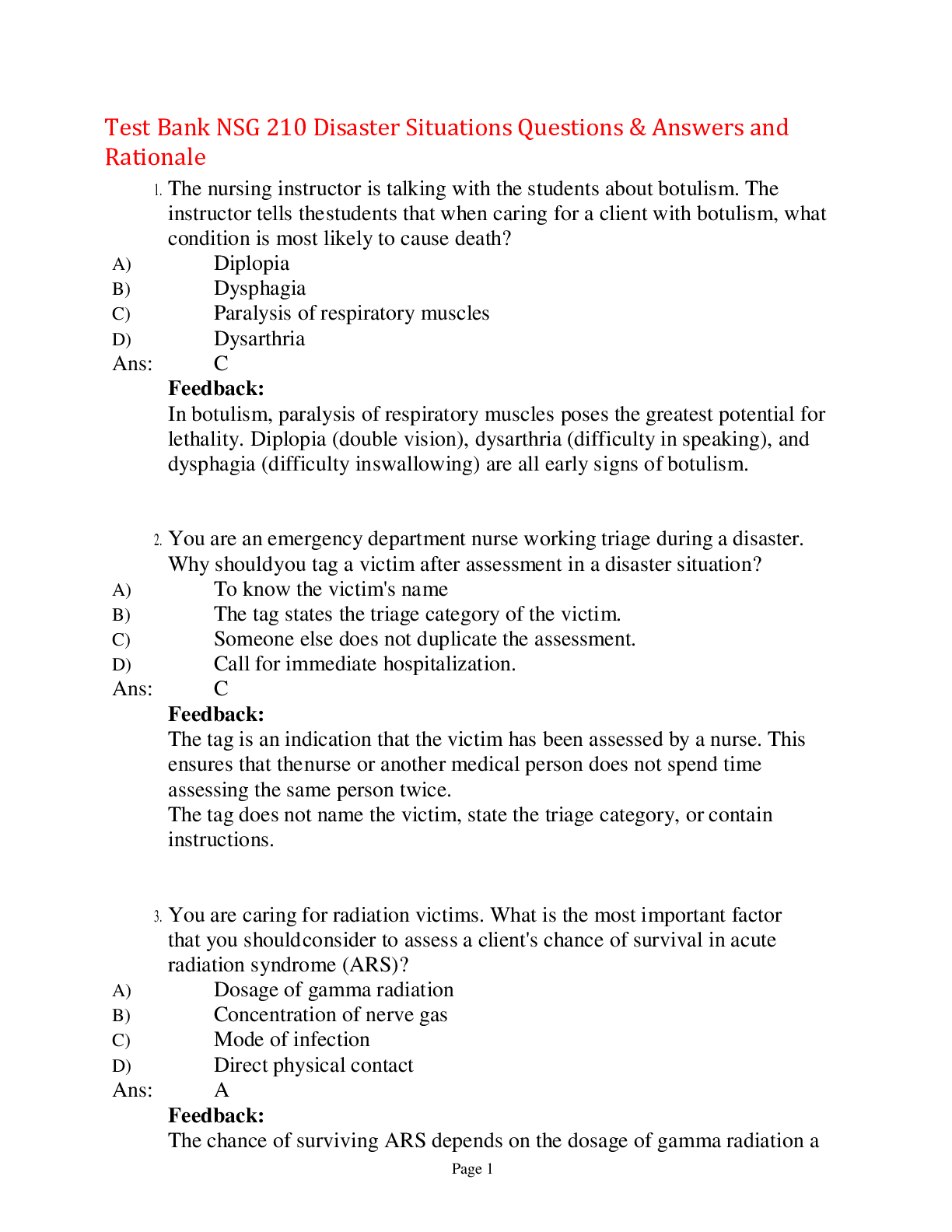
Reviews( 0 )
Document information
Connected school, study & course
About the document
Uploaded On
Sep 16, 2022
Number of pages
23
Written in
Additional information
This document has been written for:
Uploaded
Sep 16, 2022
Downloads
0
Views
37










